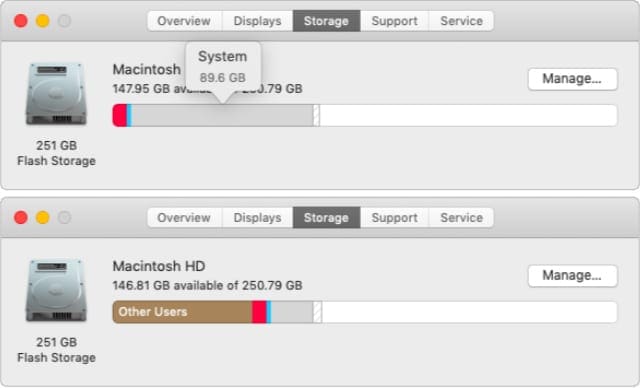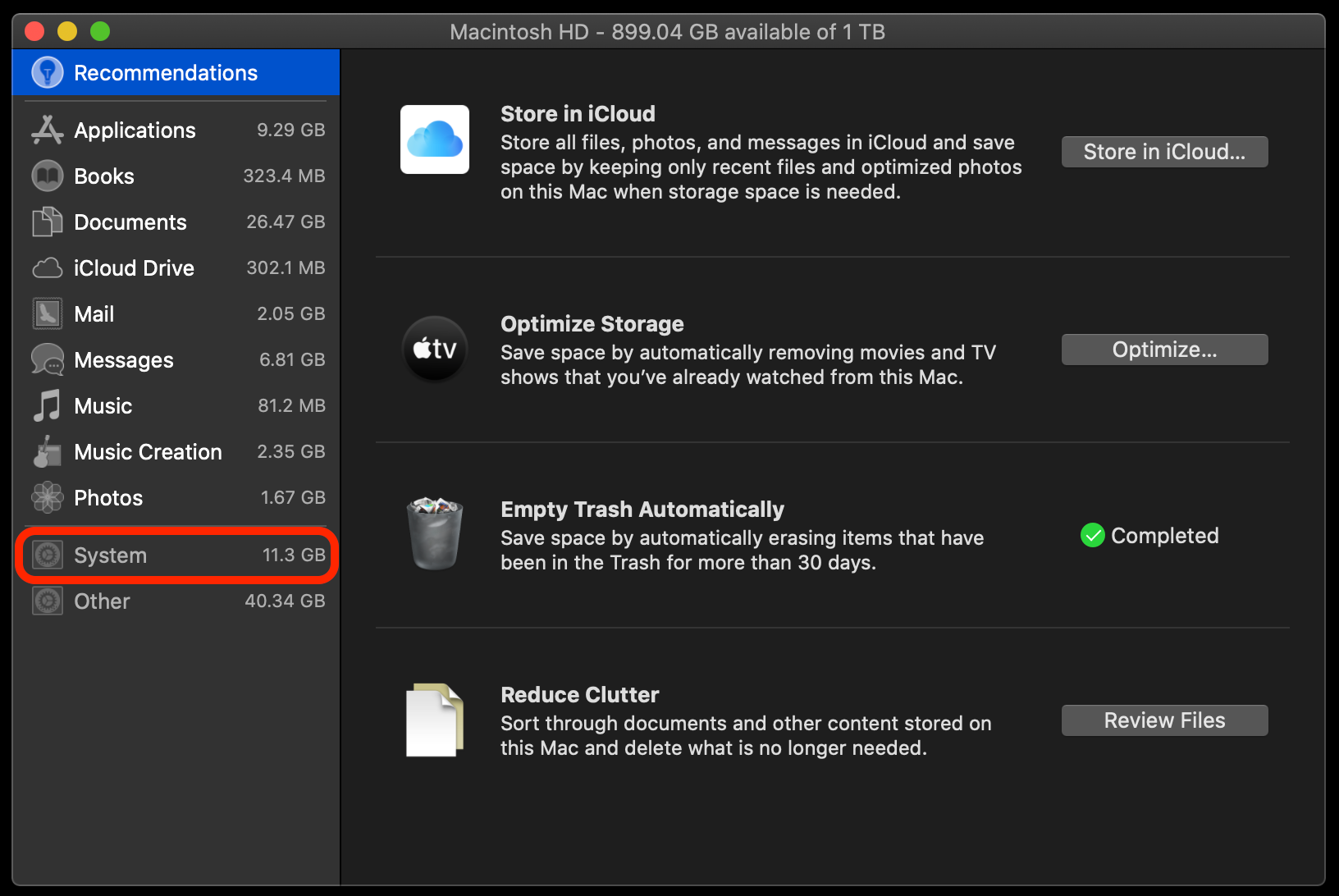The rule advises keeping 15% of the system’s storage empty. It has many benefits like you will definitely notice a hike in the speed of the system. The best part is space that is left empty can be used as a scratch disk that means you will always have space for cache and temp files. What is Other on Mac Storage? Simply, Other storage on Mac consists of files that do not easily fall into the clearer category labels like 'Audio.' The types of 'Other' files would include: Documents like PDF,.psd,.doc, etc. MacOS system and temporary files. Cache files like user cache, browser cache, and system cache. Another way to free up RAM on Mac is to clear it of cache files. Of course, it won’t save you gigabytes of space, but deleting cache regularly, you can help your Mac run faster and avoid system issues. So, to remove cache files on your Mac, you need to: Open Finder. From the Go menu, select Go to Folder.
- Methods to clear system storage on Mac.Download CleanMyMac X free edition here:How to clean up Mac OS system storage:1.
- All these files just sit on your Mac and take up precious space. Here’s how you can quickly delete them in a few clicks. Download and open Gemini 2; Choose a folder and click Scan for Duplicates; Wait for the scan to finish; Now you can Click Smart Cleanup to get rid of.
By Nathan E. Malpass, Last updated: August 27, 2019
Some Macbook users complain that their system occupies so much room on Mac and want to know the methods of how to remove system storage on Mac. If your MacBook or its storage space is relatively small, huge system storage could be quite difficult. Mac has a hard drive that is limited to fast completion, especially if you have plenty of files. Luckily, simple, fast options are available for clearing system storage on mac.
Tips:
Why Should We Clean System Storage
How Do I Clear My Mac System Storage For Free
Basically, by removing files or other items you've downloaded, you can space on your Mac freely but usually, it is not sufficient. Most wasteful space on your Mac will be recovered by addressing deeper elements such as duplicate files, language files, attachments, temporary or empty files of your Mac repository.
It is better to know the system storage on Mac before we get to the solution. On Mac and in storage, we can see that Mac storage is divided into several groups, such as photos, apps, iOS files, audio, system, etc. And the storage in the system is confusing and it's difficult to know what is in the system. In general, system files cannot be categorized in the system storage.
If you do not keep the hard drive of your Mac clean, then you eventually get the 'Your drive is nearly full' error so that you can also start up some space now.
How to Clean System Storage Easily
You can use FoneDog PowerMyMac to get rid of temporary files, remove additional language files, uninstall applications; get rid of extra files that are left by the uninstalling of applicants, look for, and get rid of large attachments stored in the e-mail and much else if you are not willing to spend some more time finding and cleaning things manually.
It basically contains all of the cleaning features in one application and naturally, there is a free trial that demonstrates where your free space has gone and can clean some free of charge.
FoneDog PowerMyMac has been developed to clean up your unnecessary caches on your Macbook such as System and Application Cache, System and User Logs to optimize efficiency and free up storage space.
1. Launch the program
Start the program and check the main interface system status.
2. Go to System Junk
On the top side click on Cleaner and then select System Junk
3. Start scanning
Click System Junk and begin scanning System Cache and Application Cache on your Mac. The scanning course can be seen in the left circle.
4. View Results
Look at the items. You can also return to the previous page for re-scan if necessary.
5. Select to begin Deletion
Select and delete desired system files.
6. Deletion process
To remove system junk files on Mac, click the Clean button. All unnecessary files are deleted.
7. Delete confirmation
After you click Clean, please click the Confirm button. Then wait for the cleaning process, be patient.
It will delete system junk files from your device quickly and easily. Note that other tools in the PowerMyMac Cleaner Modul are subject to the same steps.
How to Clean System Storage Manually
Besides the others, using FoneDog PowerMyMac is an efficient way of deleting system storage on mac. You can easily free up space on your device with just a few clicks on your mouse and easy steps.
The MacOS system and its system files were unable to delete, but the rest of the list could be deleted to free system storages. To ensure that the system works successfully on the computer. Most system storage files are difficult to find and the amount of this type of file is huge. We could even mistakenly delete some major files
System Cache and Log Files Deletion
System logs record system applications ' activity and services that take up plenty of space on your Mac. They are useful for debugging the developer but usually are useless to ordinary users. First, you can access/locate system log files on macOS to delete files. It normally involves type in the code on Mac and then delete these files manually in the trash. For users that do not know the macOS system, this could be too complicated.

Mail Attachment Deletion
When you receive them to review offline, every email and its attachment shall be cached on your mac. The build-up of mail attachments will place huge pressure on the storage of the system. You must get rid of attachments you no longer need to reduce system storage on Mac. If you need to remove too numerous attachments as well as the mail cache.


Useless Files from iTunes Deletion
Certain of you can use MacBook to back up iPhone or iPad information via iTunes. Updates of the iOS system may even be done by iTunes, which can make system storage very important for updated files and for iTunes backup. The iPhone backups and iOS updates can deplete stock on Mac to gigabytes without any knowledge. Deleting iTunes is a great way to clean up Mac system storage.
Empty Trash
How To Clear System Storage On Mac
Dragging the not-needed files in the Trash does not mean that the Mac is completely deleted, but it does. We often forget about the files in Trash and it is very easy to stock and therefore becomes a big part of system storage
Time Machine Backup Deletion
Time Machine operates both with remote and local backup storage devices when backups are done via Wi-Fi. And the local backups will still increase the system storage of your computer. Although macOS purges the Time Machine backup locally automatically if 'not enough storage disk' is available on the Mac, the removal is sometimes behind the storage change. It is thus important to manage the backup of Time Machine. Here we recommend working on how to manually remove backup Time Machine files on Mac. But be aware, although this method can help to delete Mac backup files and to free up more system storage space, you can also wait for the MacOS to delete them in case you are afraid of deleting some important backups alone.
People Also ReadiOS Update Deleted Photos, How to RecoveriPhone Photos Disappeared from Camera Roll.
Conclusion
You have a lot of cleaning on your Mac and FoneDog PowerMyMac does this for you with a simple click. It filters and displays everything in your Mac. Selecting items openly and checking the results by size, time and so on. It selects only documents to be deleted. You only sort the right files, therefore. The PowerMac app has great features so that your Mac gains more space. You can choose to make use of the excellent highlights of PowerMyMac at an affordable cost, like most valuable toolboxes. Here too, the free trial can be seen.
How Do I Clear System Storage On My Mac

How To Delete System Storage On My Mac
